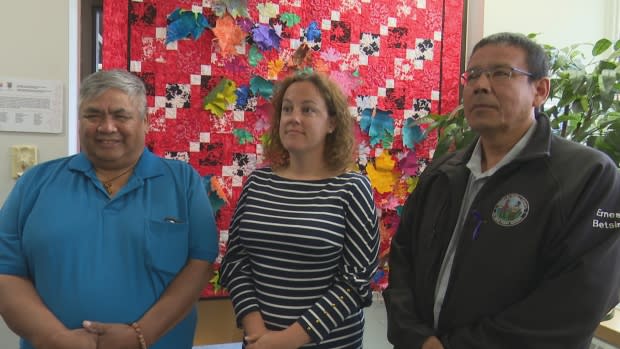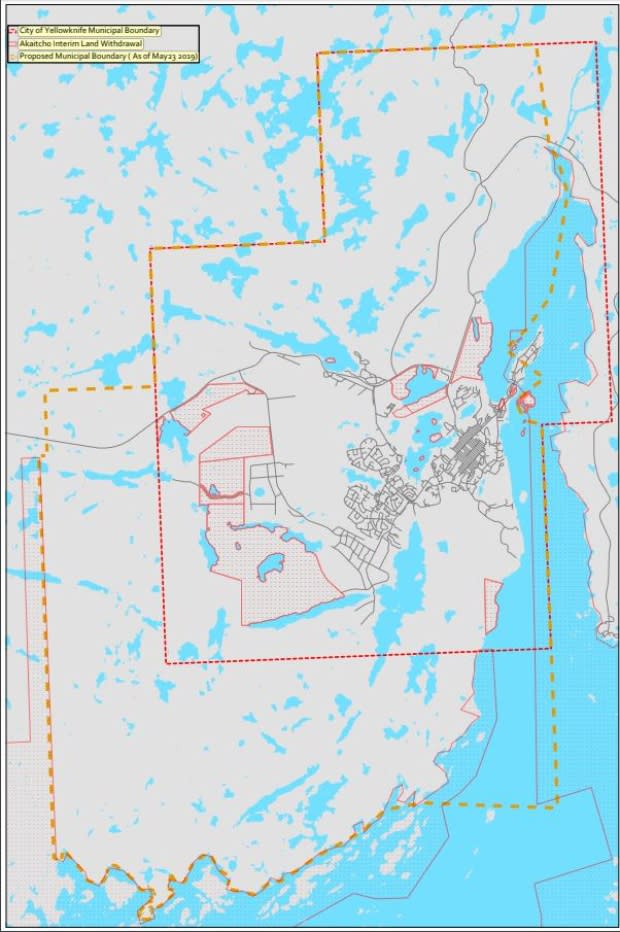Yellowknives Dene, city propose new municipal boundary
The City of Yellowknife and the Yellowknives Dene First Nation are united behind a proposal to change the city's boundary, relinquishing lands north of the city, while expanding Yellowknife south and west.
The Yellowknives Dene passed a band council resolution favouring the change in June. City councillors will vote next week on whether to apply to the territorial government to adjust the boundary. They spoke largely in favour of the move at Monday's governance and priorities committee meeting.
The City of Yellowknife municipal boundary currently covers 136 square kilometres. The proposed boundary would cover 210 square kilometres.
The newly proposed boundary would remove Ndilo from Yellowknife while keeping half of Latham Island within the municipality. It would also remove Jolliffe Island from the city.

Ndilo Chief Ernest Betsina said he wants Yellowknives Dene communities to be officially administrated together. Right now, Ndilo falls within the jurisdiction of Yellowknife, meaning only Detah can access federal and territorial funding.
"Detah and Ndilo, we want to be as one," he said.
Ndilo has to go through Detah to ask the federal or territorial government for money, said Betsina.
"I'm hoping that the process would be a lot easier now," he said.
Akaitcho Dene First Nations, of which the Yellowknives Dene are a part, are currently negotiationg a land claim with Canada and the territorial government.
They're working on an agreement-in-principle for land, resources and self-government. This community boundary is part of that process.
City boundaries allow for growth, says mayor

The land freed up through a proposed boundary change is ideal for the city's expansion, said Mayor Rebecca Alty.
The southwestern addition would help the city tackle its land shortage and make room for infrastructure like sewage. It would also allow Yellowknife to expand its waterfront access, accommodate recreational boaters and boost tourism, states a city memo.
"Going north we have Giant [mine], and to the east we have Great Slave Lake, so that's our growth for the next 50 years," said Alty.
Part of the withdrawal includes Jolliffe Island, the hub of Yellowknife's houseboat community.
Whil Coun. Julian Morse said the change has the potential to be "historic," and improve relations between the city and Yellowknives Dene, he said the city will have to carefully weigh how it deals with this area.
"Some of these aspects of Yellowknife are really what give it its character," he said.
Morse also called for the city to form an agreement with Yellowknives Dene on land use and co-management in the interim.
"Let's ensure we're moving forward with something that is going to preserve those aspects of our community and also help enhance [Yellowknives Dene] access to lands," he said.
Yellowknife 'bursting at the seams'
Once the city makes its application, the N.W.T. Department of Municipal and Community Affairs will still have to consult affected Indigenous governments in accordance with Section 35 of the Charter.
Once the department gets the request, and completes its consultation, it will bring a recommendation for the minister's consideration, said Eleanor Young, deputy minister for the department.
Boundary changes are usually achieved through a self-government negotiation, as with the Deline Got'ine Government, said Young.
Ndilo and Detah could wait until Akaitcho is resolved, but the City of Yellowknife is "bursting at the seams" and needs to address land issues, she said.
She said the department is looking forward to getting the formal request.


